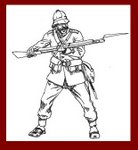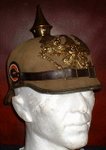

The early Imperial Japanese Army was essentially developed with the assistance of French advisors, through the second French Military Mission to Japan (1872-1880), and the third French Military Mission to Japan (1884-1889). However, due to the German victory in the Franco-Prussian War, the Japanese government also relied on Prussia as a model for their army, and hired two German military advisors (Major Jakob Meckel, replaced in 1888 by von Wildenbrück and Captain von Blankenbourg) for the training of the Japanese General Staff from 1886 to April 1890: the Imperial Army General Staff Office, created after the Prussian Generalstab, was established directly under the Emperor in 1878 and was given broad powers for military planning and strategy. Other known foreign military consultants were the Italian Major Pompeo Grillo, who worked at the Osaka foundry from 1884 to 1888, followed by Major Quaratezi from 1889 to 1890, and the Dutch Captain Schermbeck, who worked on improving coastal defenses from 1883 to 1886.
Japan did not use foreign military advisors between 1890 and 1918, until again a French Military Mission to Japan (1918-1919), headed by Commandant Jacques Faure, was requested to assist in the development of the Japanese air services.
Satsuma rebellion
Not surprisingly, the new order led to a series of riots from disgruntled samurai. One of the major riots was the one led by Saigō Takamori, the Satsuma rebellion, which eventually turned into a civil war. This rebellion was put down swiftly by conscripts in the newly- formed imperial army, trained in Western tactics and weapons, even though the core of the new army was actually the Tokyo Police force, consisting mostly of former samurai.
An imperial rescript of 1882 called for unquestioning loyalty to the Emperor by the new armed forces and asserted that commands from superior officers were equivalent to commands from the Emperor himself. Thenceforth, the military existed in an intimate and privileged relationship with the imperial institution. Top-ranking military leaders were given direct access to the Emperor and the authority to transmit his pronouncements directly to the troops. The sympathetic relationship between conscripts and officers, particularly junior officers who were drawn mostly from the peasantry, tended to draw the military closer to the people. In time, most people came to look more for guidance in national matters to military commanders than to political leaders.
By the 1890’s, the Imperial Japanese Army had grown to become the most modern army in Asia, well-trained, well equipped and high in morale. However, it was basically an infantry force which at times was deficient in cavalry and artillery when compared with its European contemporaries.































3 comments:
Another great find and of definite use (to you especially!...good job.
nicely done with the colors on the main pic, I know in the original they were green!
James, a good painting guide...)
Post a Comment